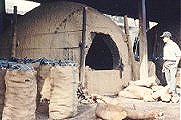

Thailand 
 |
Wood Energy Situation Policies and Programmes Wood Energy Data Further Reading RWEDP Focal Points |
Wood Energy Situation
The social and economic transformations of Thai society over the last two decades have resulted in higher per capita income and a rapid growth in energy consumption. Consequently, the share of woodfuels in the total supply of energy has been declining from 27% to 17% between 1986 and 1996. Nevertheless, in absolute terms wood energy consumption has been increasing with a rate of 5.3% annually between 1986 and 1996. As this trend is partly overshadowed by a stronger increase in conventional fuels, the situation has not always fully been acknowledged by policy makers. Biomass energy, consisting mainly of fuelwood and charcoal supplied 49% of the total household energy in 1996. Woodfuels are widely used for cooking in rural areas and semi-urban, but charcoal also remains popular in urban areas including Bangkok.
About half of the wood energy in Thailand originates from sources other than forests. The process of gradually converting forests into agricultural land seems to continue. This could lead to localised scarcities as wood and charcoal remain widely used. Data shows that the general logging ban, initialised by the government in 1989, had no effect on the ongoing process of deforestation.
Policies and Programmes
Since early 1995 the Royal Forestry Department (RFD) has been expanding its staff and budgets for wood energy. The National Energy Policy Office (NEPO) has embarked upon an active energy conservation programme which includes biomass energy and rural based industries.
Efficient wood and charcoal stoves are widely used in urban as well as rural areas. The stove designs (Thai bucket) have often served as a model for other countries. Furthermore, Thailand is interested in modern wood/biomass energy technologies, including combined heat-and-power generation.
Wood Energy Data
| General | |||||
| Population (1996) | 58.7 mln. | ||||
| Share of Rural Population | 80.0% | ||||
| GDP per capita (1995) in constant 1987 US$ | 1,803 | ||||
| Energy Consumption (1996) | |||||
| Total Final Energy Consumption in PJ | 2,212.6 | ||||
| Consumption of Wood Energy in PJ | 369.9 | (16.7%) | |||
| Consumption of Biomass Energy in PJ | 521.6 | (23.6%) | |||
| Wood Energy Resources | |||||
| Forest Area (1995) in 1000 ha | 11,630 | (22.8%) | |||
| Natural Forest Area (1995) in 1000 ha | 11,101 | (21.7%) | |||
| Agricultural Area (1994) in 1000 ha | 21,245 | (41.6%) | |||
| Share of Woodfuels from Forest Areas (1992) | 37% | ||||
| Potential Wood Energy Supply (1994) | |||||
| Sust. Supply from Natural Forest in kton | 10,840 | ||||
| Sust. Supply from Forest Plantations in kton | 1,902 | ||||
| Sust. Supply from Agriculture Areas in kton | 23,243 | ||||
| Supply from Wood Waste from Deforestation in kton | 31,046 | ||||
| Total Potential Supply in kton | 67,030 | ||||
| Primary Wood Energy Requirements in kton | 46,069 | ||||
Notes:
Population and land use data from FAO (FAOSTAT), GDP per capita from World Bank. Energy consumption data from various sources.
Potential wood energy supply estimated by RWEDP, based on available data for land use, wood productivity and estimates on availability of wood for energy use. For forest land, other wooded land and agriculture areas, the potential supply is based on average annual yield estimates, assuming a sustainable use of resources (Sust.: sustainable). Wood waste from deforestation refers to wood potentially available from natural forest land cleared due to commercial logging, expansion of agriculture land or other reasons. The estimates are based on aggregated national data, which can hide local variations, ranging from scarcity to abundance. For detailed calculations and estimates for 2010, see FD50, chapter 8
Further reading:
| Images of Wood and Biomass Energy in Industries in Thailand, Field Document 52, Field Document 52, 1998 | |
| Data Collection & Analysis for Area-Based Energy Planning, A Case Study in Phrao District, Northern Thailand, Field Document 48, 1997 | |
| Regional Study on Wood Energy Today and Tomorrow in Asia, Field Document 50, 1997 | |
| Chapter 16 in Review of Wood Energy Data in RWEDP Member Countries, Field Document 47, 1997 | |
| Biomass Energy in Asean Member Countries, 1997 | |
| Mangrove for Charcoal, A vanishing Sustainable Woodfuel Resource System - The Case of Yeesarn, Field Document 30, 1992 | |
| Part V "Urban-Rural Wood Energy Interdependency in a District of Northeast Thailand" in Woodfuel Flows, Rapid Rural Appraisal in Four Asian Countries, Field Document 26, 1991 | |
| Charcoal in Northeast Thailand, Rapid Rural Appraisal of a Wood-Based, Small - Scale Enterprise, Field Document 9, 1988 |
RWEDP Focal Points in Thailand
Focal points are the main contacts for RWEDP in a member country. Generally, in each country, there is one focal point in the energy sector, and one in the forestry sector.
| Director General Attn.: Head of Wood Energy Research Subdivision Royal Forest Department Phaholyothin Road, Bang Khen Bangkok 10900 TEL: 66-2-5614292/3 FAX: 66-2-5798611 | Director General Department of Energy Development and Promotion Kasatsuk Bridge, Rama 1 Road Bangkok 10500 TEL: 66-2-2237893 FAX: 66-2-2261416/2240914 |
Comments, questions? webmaster@rwedp.org
© FAO-RWEDP, 1999